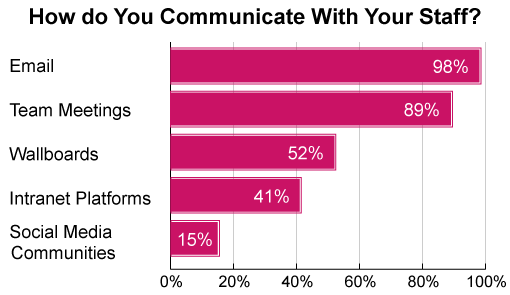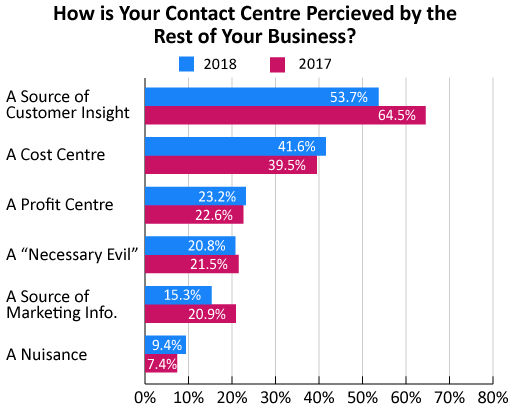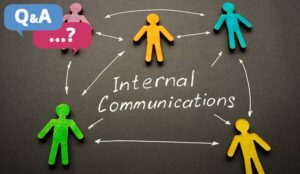To build a great contact centre culture, you first need to ensure that you are communicating effectively with your advisors and other internal groups.
Here we present eight tips for improving internal contact centre communication, after we’ve taken a quick look at what might be holding you back.
Why Do We Need Good Internal Contact Centre Communication?
There are a number of reasons why having good lines of communication throughout the contact centre is key. Perhaps the most obvious benefit is so that the team can share knowledge with one another, to improve call handling.
Another benefit would be to ensure that advisors feel fully listened to and supported, as if you create the space for advisors to voice their grievances with systems, processes or whatever, you’ll know how to improve their experience.
Another benefit would be to ensure that advisors feel fully listened to and supported, as if you create the space for advisors to voice their grievances with systems, processes or whatever, you’ll know how to improve their experience.
Then, there are your workforce management (WFM) benefits. For example, if there is good communication, advisors can easily shift-swap, which will likely reduce absenteeism.
While there may be more reasons for improving contact centre communication, such as better informing advisors of key updates to products and services, these are perhaps the most fundamental.
If you’re looking for ideas to improve internal communication across the business, not just inside the call centre, read our article: Call Centre Management: From Cost Centre to Strategic Resource
What Are the Challenges to Good Internal Communication?
Before we look at some methods of improving communication within the contact centre, we need to be aware of any barriers that are impacting our current operation. Here are a few examples of the challenges to internal communication.
High Volumes of Internal Emails
In many contact centres, email is the only channel through which advisors can communicate with management, meaning that emails are constantly sent for reasons such as shift-swaps, organising social events, lost property and so on.

Our research found that email is used for internal conversation in 98% of contact centres (source: Effective Internal Communications in the Contact Centre)
When this is the case, managers and team leaders spend too much of their day managing their inbox, often repeating the same messages over and over again, instead of having more valuable advisor conversations.
High Attrition Rates
Contact centres are often synonymous with high attrition rates, meaning that new people are constantly being recruited. This high turnover makes it difficult to create lasting relationships within the workplace.
Without strong relationships, advisors are less likely to communicate effectively with one another, which also has a negative influence on culture.
Lack of Advisor Engagement
If advisors have little passion for their role, they are unlikely to be interested in enjoying the more social side of the job and passing on ideas for improving various processes.
We need to get advisors invested in any initiative that we plan to use to improve communication.
We need to get advisors invested in any initiative that we plan to use to improve communication. We shouldn’t just add a function and hope advisors communicate better, so it is better for them to help us develop the function, so they are more engaged with it.
Isolated Teams
Many contact centres are still set up so that one team is responsible for each channel and sometimes there is very little interaction between teams. This makes it difficult to communicate any contact-centre-wide plans.
Often, when advisors from different teams are given the opportunity to communicate with one another, it’s on social occasions where their working lives are put on the back-burner.
Stagnant Lines of Communication
Too often it is the case that the daily routine of a contact centre manager/leader consists almost entirely of firefighting, with no planning ahead.

Too often the daily routine of a contact centre manager/leader consists almost entirely of firefighting, with no planning ahead.
Managers and leaders were likely promoted from other areas of the contact centre and may have just carried on with their predecessor’s example, not changing any key processes.
However, how advisors like to communicate is changing and those old processes may not be as effective as they once might have been.
The Eight Ways to Improve Contact Centre Communication
Now we know our blockers to effective communication, it’s time to see what we can do to smooth-over these challenges and start to build a more positive culture.
1. Create an Online Community
Having an online community page for which every member of the contact centre team is given a profile is a great way of sharing tips, announcements and reducing internal email traffic.
In 2015, OVO Energy’s contact centre introduced a Google Plus Community group, which was developed with the help of some of the company’s advisors, to really engage them with the idea of knowledge sharing via this social media platform.

Katie Bunting
Katie Bunting, an Internal Communications Manager at OVO Energy, says: “Not only is it more of an engaging format, it’s much easier to have a quick scan of the community page than respond to every email, which is great in terms of managing time.”
“We have sections for shift-swaps, lost and found and various HR announcements, while we have also found the group to be a great place for reward and recognition. This can be anything from ‘Advisor of the Week’ competitions to sharing great customer feedback.”
Already, community group has had a great impact in terms of celebrating advisor success and building a positive culture. Yet Katie also reports that the community group has helped OVO Energy to better communicate with the team by:
- Setting useful reminders for advisors
- Making important announcements
- Crowdsourcing ideas for culture improvement
To find out more about OVO’s community page, read our article: A Simple Way to Improve Communication in the Contact Centre
2. Pass on New Information at a Consistent Time and Place
In the contact centre, you’ll often receive updates from the marketing, design and/or creative departments, which need to be digested by advisors and shared with the customer. So we need to generate as much time as possible to effectively communicate the messages with the team.
OVO Energy’s contact centre has worked hard to form relationships with other areas of the business to gain more time, while they have also asked them to fill in a briefing form.
We are really strict on deadlines with our briefing forms. If other departments don’t meet the deadline, their request will have to wait until the next day.
Katie Bunting
Explaining this process, Katie says: “We have a brief form, where other departments share important information that they would like us to pass on to our customer-facing team.”
“Then, we send one daily update to each advisor, via email, at 7:30am. It contains all the new information that they’ll need for the day ahead and, because we are really strict on deadlines with our briefing forms, if other departments don’t meet the deadline, their request will have to wait until the next day.”
Creating this simple process has meant that advisors know exactly when and where they have to look for new updates, so they can go into each call confident that they have all the new information that they need.
Also, if there are no new updates for the day ahead, OVO Energy still send out the email at 7:30am to reassure advisors that they are up to date with everything that’s important.
3. Develop Listening Mechanisms
According to Katie Bunting: “We [OVO Energy] wouldn’t have had the success of our community group or daily updates, if we hadn’t first listened to our employees.”
This highlights the need for having open lines of communication between all levels of the contact centre. Therefore, we should be developing listening mechanisms so the communication works both ways.
Below are six different methods of listening to advisors that OVO Energy have successfully implemented in their contact centre.
i. Weekly feedback focus groups – OVO Energy’s Customer Service Director meets with a different group of advisors every week to get a better idea for how they’re feeling, the challenges they face in the job etc. When the group start speaking about something passionately, you know you’ve hit upon something.

When the focus group start speaking about something passionately, you know you’ve hit upon something.
ii. Quarterly Q&A sessions – This is where 50 advisors have an open Q&A session with the senior management team, in which they can ask anything they want. These sessions are recorded and fed back to the rest of the department.
iii. Scorecard Advocates – These are nominated advisors who represent their fellow advisors in scorecard meetings, so the wider contact centre team has a voice in how their performance is being assessed.
iv. Straight Talking – If OVO Energy have an issue that has come up a number of times, they’ll give what they call a “straight talking answer”. By signposting this conversation as “straight talking”, everyone involved can prepare for an open and honest interaction, where there is a comfortable space for saying what needs to be said.
v. The Think Tank – If advisors have a great idea for improving an area of service, but don’t want to wait until they are called in for focus groups or Q&A sessions, OVO Energy also use a “think tank” on their community page. Advisors can then post ideas and the management team can respond and look at the number of engagements (like and comments) to assess the idea’s popularity.
vi. The knowledge base – In their knowledge base, OVO Energy provide advisors with a lot of space for questions and comments, so they can let the management team know if the information is as up to date and effective as it possibly can be.
4. Personalise Internal Communications
To engage advisors more with your communications, it’s important to ensure the information they receive is relevant to them. One way to do this is by personalising your central intranet system.
OVO Energy do this and Katie Bunting says: “It has allowed us to segment information, so while it is group-wide intranet, we can provide specific content for customer services on there, which helps to drive traffic to the site because it’s relevant and interesting to the team.”
“Having this ability to personalise things allows you to deliver some nice surprises. For example, it allows us to do pop-ups for key advisor milestones, such as birthdays, work anniversaries and other key celebrations/achievements.”

Take a look at the nice intranet pop-up that OVO Energy advisors receive on their birthday.
While these pop-ups may seem small, if we recognise and celebrate advisor landmarks/success on our communications platforms, it better engages the team with them.
Also, little gestures from time to time are nice for advisors to feel cared for, and if they feel as though they are an important part of the organisation, they are more likely to take interest in internal communications.
5. Give New Advisors the Opportunity to Make an Impact Right Away
One of the key blockers to good communication is high attrition rates, as having advisors constantly come and go makes it difficult to form good relationships, which are key to good conversations.

Caroline Cooper
With this in mind, Caroline Cooper, a Trainer and Consultant at Naturally Loyal, says: “In the first few weeks in a new job, it’s not unusual for an advisor to think that they are not contributing very much. So it’s easy to become a bit disillusioned.”
“To avoid this, give them a little project very early on, something that is relevant and will make an impact on the business and for their team.”
Ideally this project will give the new starters an opportunity to communicate with other members of the team, which helps to break down conversational barriers and gets advisors working together.
Alongside opening up these lines of communication, by giving new recruits a chance to make an impact, you can engage them better with key business processes.
6. Start the Day With a Team Huddle
Starting the day with a team huddle provides the ideal opportunity to make announcements, update the team and ask questions.
Fat Face’s contact centre in Havant have a morning team huddle, finding that the initiative has helped to reduce email traffic, while it has also helped to enhance the sense of community and team spirit.
Fat Face’s contact centre in Havant have a morning team huddle, finding that the initiative has helped to reduce email traffic, while it has also helped to enhance the sense of community and team spirit.
But that’s not all. Research has found that huddles can improve team focus, with one study finding that when doctors have a pre-surgery huddle with their team before an operation, the total in-hospital rate of death dropped from 1.5% to 0.8%.
While it’s a very different field, the results still highlight the value of a huddle, and Fat Face don’t stop there. At the end of the huddle each member of the team strikes a “power pose”, with the aim of creating as big a stance as possible. This is because the idea of making such a pose has been linked with instilling confidence, which is an interesting was of creating an air of positivity.
7. Appoint Reps for Key Social Issues
One way to improve communication in the contact centre is to engage advisors in conversations about things that personally matter to them.
For example, if you appoint reps – for things like mental health, LGBT and BAME causes – and give them space to plan events and raise awareness, you can help to spark positive conversations.
These reps can work in teams, so advisors from different team can discuss things that matter to them, which helps to build a sense of community.
If you can build this sense of community, you can break down communication barriers, like having isolated teams, and advisors will be more willing to go the extra mile to help out their colleagues.
Other ideas that may help to build a better sense of community in the contact centre could include:
- Getting together to support local charities
- Play motivational games in teams to promote healthy competition
- Ask advisors if they’d like to organise fun social events
Sky’s contact centre in Stockport has a number of reps who raise awareness for important causes. To find out more, read our article: 14 Fresh Ideas From the Sky Contact Centre
8. Consider the Impact of Workforce Optimisation (WFO) Tools
Blending front- and back-office operations using workforce optimisation (WFO) tools and techniques can be a good way to improve communication within the contact centre.

Scott Budding
Scott Budding, a Workforce and Process Optimisation Manager at Business Systems, says: “Communication across teams tends to improve where a blended workforce is deployed as staff generally become more collaborative in their efforts to achieve common goals.”
“Also, communication to customers improves as proficiency levels increase across a blended workforce. Staff are exposed to multi-skilled tasks and are no longer able to cherry pick work, resulting in a better outcome for the customer.”

Neil Hammerton
While the focus has been very much on internal communications, WFO tools can also improve customer conversations.
Neil Hammerton, CEO and Co-Founder of Natterbox, also recommends: “Smart solutions that allow contact centres to record information about every conversation they have with a customer over the phone. This allows managers to listen to recorded calls to identify trends and spot potential areas for staff improvement.”
Communicating With Other Departments
Just a quick reminder that while improving communication across the entire contact centre is great, it should be a goal to have strong ties of communication with other departments within the business, to improve the customer experience.
For many contact centres this can be difficult, as our 2018 research suggests that 39.5% of organisations still view the contact centre as a “cost centre”.

However, this percentage had decreased from the figure recorded in 2017, highlighting that more organisation are starting to realise the value of the data and knowledge that is stored within the contact centre.
In fact, by simply having advisors talk to marketing and the design teams about common customer preferences and bugbears, the contact centre can help to positively influence future marketing campaigns and product designs.
This example showcases the value of the contact centre, so having good ties of communication between departments can really help to tighten up customer journeys.
One way that Which?’s contact centre in Cardiff does this is by sharing monthly presentations with marketing. This has an additional WFM benefit, as if the contact centre team knows when new marketing material is released, it can prepare for any resultant spikes in contact volumes.
To find out more about sharing useful information with other departments, read our article: Drive the Voice of the Customer Into the Wider Business for Real Change
In Summary
Effective internal communication is great for better supporting advisors, sharing valuable knowledge and improving processes.
However, in the contact centre there are many things that make it difficult to achieve good communication, such as excessive email volumes, high attrition rates and isolated teams.
To remove these blockers there are many things that we can try, which could include creating an online community, developing listening mechanisms and implementing WFO tools.
Finally, don’t forget the benefits to the customer experience which good communication between the contact centre and other departments can have. So, try to build those relationships to better support your team and your customers.
Good luck!
For more on improving contact centre communication, read our articles:
- What to Include in Your Daily Briefing Sessions or Virtual Huddles
- 7 Clever Ways to Improve Internal Communication Between Departments
- 10 Great Conversations to Have With Your Contact Centre Team
Author: Jonty Pearce
Published On: 13th Mar 2019 - Last modified: 14th Aug 2025
Read more about - Customer Service Strategy, Business Systems, Caroline Cooper, Communication Skills, Editor's Picks, Email, Natterbox, Scott Budding, Service Strategy, Team Management





































